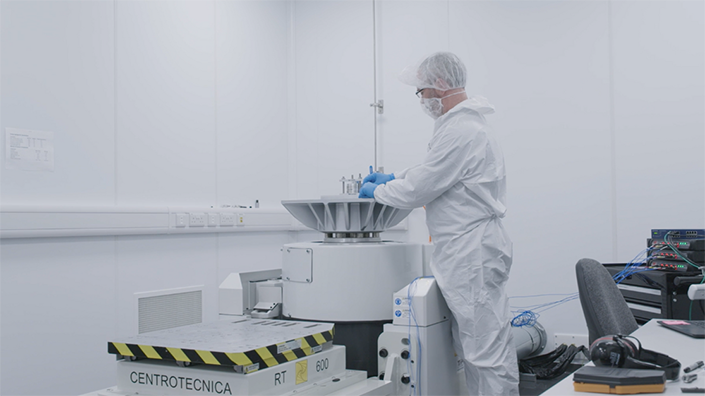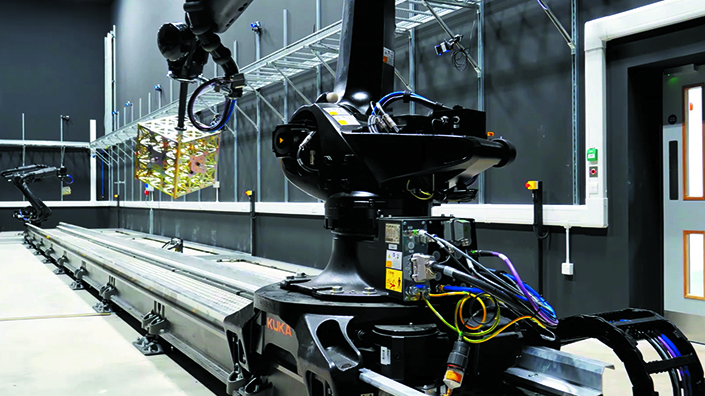The tests might have indicated that parts could be useful in space, manipulating satellites or assembling structures in orbit. Instead, the severe radiation caused components to fail within six months, showing they were insufficiently ‘hardened’ for the harsh environment. Rather than shooting for the stars, the robot found itself unceremoniously abandoned in one of the power plant’s cooling pools.
Today, robotics and satellite testing are more sophisticated – and much more important, as the number of satellites being launched rises dramatically and they play an increasingly central role in communications, climate-change studies, logistics and more. According to the United Nations, humanity launched 2,163 objects into space in 2022, up from 134 in 2012. That rise, driven largely by SpaceX Starlink satellites, is also increasing the risk of space debris, which will require some advanced solutions.
The Satellite Applications Catapult is putting satellites to the test to ensure that they can tackle the problems of the future. To do so, it is creating some of the least hospitable conditions on Earth.
Turning up the heat
Most electronic devices would not survive in orbit – without protection from the atmosphere, satellites face extreme radiation and temperatures from roughly -150ºC to 200ºC. Materials act differently, while specks of debris and micrometeorites can cause catastrophic damage. Even before they reach their destination, devices must survive the traumatic shaking of a rocket launch.
Pre-flight testing and validation, carried out at the Catapult’s Disruptive Innovation Space Capability (Disc) facility in Harwell, Oxfordshire, needs to consider all of those risks. The 1,150m2 centre provides lab space and engineering expertise to developers, mainly organisations launching one or two satellites a year but without their own testing facilities.
Hidden beneath a face mask, hairnet and gloves to prevent any potential contamination, Disc operations manager Shane O’Leary sits in front of a thermal vacuum chamber (TVAC) in one of the centre’s clean rooms. Inside the 1.8m-long metal cylinder, cubesats are put through intense temperature differences and vacuum air pressure of about one-ten-billionth of the normal atmosphere.
Combined, the two factors can have a great effect on a satellite in space. “You want to replicate everything that it is going to experience as much as you can,” says O’Leary. “The last thing you want to do is make a mistake and have a million-pound satellite up there that doesn’t work.”

Shane O’Leary in the clean room (Credit: Satellite Applications Catapult)
The TVAC uses electrical heating to replicate the highest temperatures that critical components might be exposed to, while the centre’s environmental chamber can get down to -80ºC. On a satellite, those temperatures can be managed by adding shade or heating elements.
Vacuum conditions lower materials’ boiling points, which can cause organic materials to ‘outgas’. This could change the properties of a system, by making it lighter, for example. Heat dissipation can also lead to higher temperatures in unexpected areas, so the TVAC chamber lets teams monitor this before launch.
Bake and shake
Another key piece of equipment at Disc is the vibration table, which tends to be the last test before cubesats head to launch. “They’re scary,” says O’Leary. “You are shaking something to try to destroy what you really don’t want to be destroyed. And then they have to do functional tests, to make sure that nothing has dislodged.”
Tests last for about two minutes – “shortish and sharpish from my point of view,” says O’Leary. “From the point of view of the people who have made it, I’m sure they must think it goes on forever.”
The table shakes at frequencies of 20-2,000Hz, and the noise is equivalent to standing on a runway while a jet takes off. It only vibrates on one axis, so it has to be rotated and turned vertically for multiple tests.
As well as a ‘sweep test’, which goes through all frequencies at a low energy level to reveal resonances in the satellite, the equipment can also replicate the vibration profiles produced by specific rockets, giving satellite developers peace of mind that their kit will survive launch.
“That’s where it can get very active,” says O’Leary. “When you’ve got a satellite in there, no matter how well it’s built, it’s going to resonate, because you can’t put the same kind of strengthening structures in a satellite – because it needs to be kept light – as you could if you’re building something on Earth.”
Something breaking during the test is the worst-case scenario, but O’Leary says it has only happened to him once. The other pass criterion is whether there is a large shift in the resonances between the sweep tests carried out before and after the ‘random’ profile test, which could indicate that something has changed significantly within the structure – it might not be broken, but there is a risk of something breaking the next time it goes through the same forces.
Mission control
An hour’s drive from Harwell, the Catapult has a simulated ‘mission control’ in Westcott, Buckinghamshire. Instead of cubesats, which are roughly shoebox sized, the Westcott facility is focused on testing larger satellites and robots for In-Orbit Servicing and Manufacturing (IOSM), a relatively new field that could become much more significant in future as ageing satellites are fixed or refuelled to prevent them from becoming space debris. Other applications might include assembling the giant arrays needed for space-based solar power (SBSP) installations.
The devices being tested range from proof-of-concept technology that will never go near a real spacecraft up to devices that could feasibly be launched. Systems might include robot arms, control systems, and the sensors they need to operate. They also often include simulated power sources, guidance and navigation systems, manipulators, and some degree of communications equipment.
Robotics development lead Jeremy Hadall sits in mission control, which replicates the kind of facility that might be used during flight. “What we do here is replicate the mission level,” he says. “We assume that the hardware, at some stage, will be tested for this environment. It might be before it gets to us, it might be after it gets to us – it doesn’t really matter. The point is, we’re not concerned about how this hardware is going to survive in the space environment. What we’re concerned about is how the hardware is going to react when we put it through a ‘mission set’ of parameters.
“That means we can run the flight dynamics, we can run whatever it is that’s going to run these robots or run these systems, and we can run them within the hardware, mimic the movements and learn and understand how these space systems are going to actually work.”
He adds: “What we try to do here is get to a point where the robot systems can operate without any human intervention… I can’t see the robot labs from here, unless I use the camera systems.”

A device undergoes testing on a robotic arm in the IOSM yard (Credit: Satellite Applications Catapult)
‘Tricky operation’
Servicing defunct satellites has some significant challenges. If a satellite was last seen on the launch pad, “we don’t know what it’s going to look like, we don’t know what’s hit it, we don’t know where the bits have come off it,” says Hadall. “It’s a fairly unknown state. We’ve got to get close to it. That’s quite a tricky operation.”
That means an IOSM spacecraft would need to match its trajectory – easy enough if it is under control, but “very difficult” if not. The Westcott facility simulates the effects of microgravity by suspending the IOSM devices with robotic arms or other additional supports, replicating how they would move in space.
The craft then needs to “grab” the satellite, which, being in space, will move in the opposite direction to anything that touches it. After that comes the servicing, refuelling or other mission task.
“That itself is a whole can of worms to open up because, even now, little is designed for serviceability in orbit,” says Hadall. “We launch them, and the most we think about in terms of getting them back or reusing them or recycling them is something called ‘demisability orbits,’ where we bring it back into the atmosphere and it burns up.”
The tests provide IOSM projects with invaluable data for future operations. If a company is teaching an autonomous system, for example, it gets a training data set that can be implemented. Other projects are focused on validation tests, creating mission scenarios and making sure the system can do the same steps over and over again.
‘Living lab’
The changing economics of space launch, with many more launches and lower costs, means we might see less physical testing and increasing reliance on simulation in years to come – but, for now, it makes sense to test what you are going to launch.
“There are still processes in the build, such as soldering the circuits, where, if you’ve done that wrong and your wire breaks free, you then have got a brick flying around the world, rather than a satellite. At this stage, it’s worth their while,” says O’Leary, referring to cubesat manufacturers. He predicts that his facility could eventually test 100 each year as the UK satellite industry ramps up.
In future, Hadall suggests, IOSM devices could be tested and developed in space itself, and the Catapult is investigating the idea of a ‘living lab’ in orbit. “It would be nice to say that there is a space in space, if you excuse the pun, where we can go and test these things.”
High demand for room on the International Space Station means that this is unlikely to happen in the near future, however. Launch costs and safety requirements also make it less likely.
Until then, the next best thing will be replicating space on Earth – “we do what we can to get close to it,” says Hadall.
READ MORE: How Open Cosmos uses satellite testing to ensure its devices benefit society
Want the best engineering stories delivered straight to your inbox? The Professional Engineering newsletter gives you vital updates on the most cutting-edge engineering and exciting new job opportunities. To sign up, click here.
Content published by Professional Engineering does not necessarily represent the views of the Institution of Mechanical Engineers.